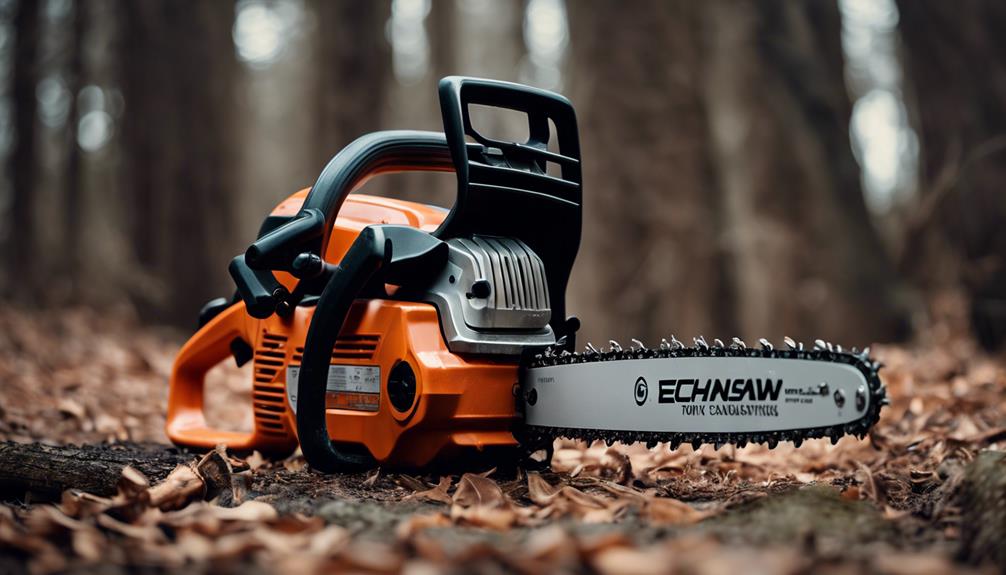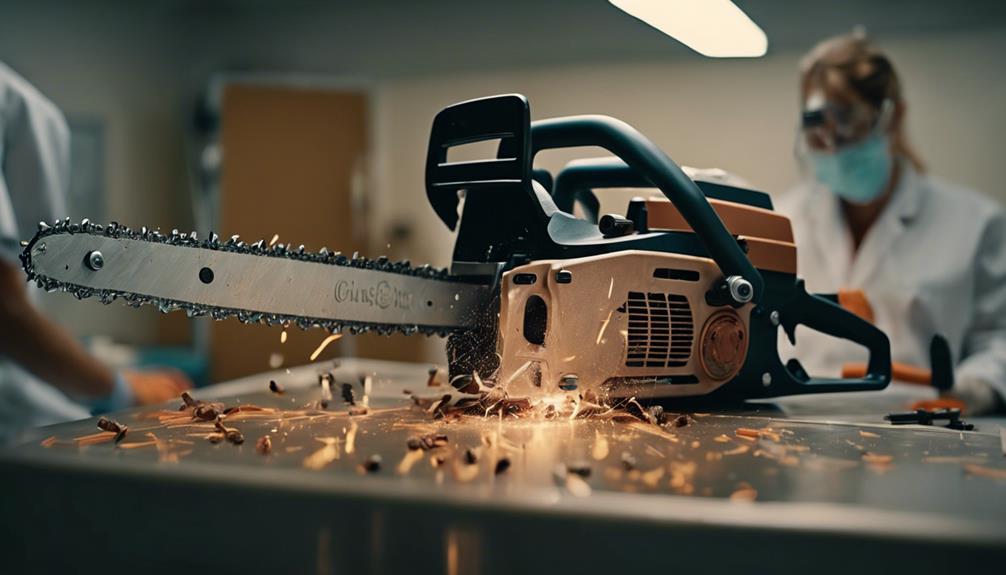Chainsaws were invented in the late 18th century by Scottish doctors John Aitken and James Jeffray for medical procedures, enhancing surgical precision. Initially used for tasks like symphysiotomy and bone excisions, the hand-cranked design allowed intricate operations. Chainsaws proved crucial in widening the pubic symphysis joint during childbirth complications and amputations in the Civil War. They moved on to the forestry industry, evolving alongside advances in technology. The impact on surgical advancements was significant, minimizing tissue damage and shaping modern surgical tools. Unexpectedly versatile, chainsaws influenced various sectors beyond medicine. Their historical significance spans from surgical precision to logging efficiency.
Key Takeaways
- Chainsaws were invented by Scottish doctors in the 1780s for surgeries like symphysiotomy and bone excisions.
- Originally designed for medical procedures requiring precision cutting.
- Used in childbirth complications and Civil War amputations due to minimal tissue damage.
- Evolution from surgical tool to forestry equipment for tree felling and wood cutting.
- Chainsaws revolutionized surgical practices, leading to advancements in modern medical tools and techniques.
Origins of Chainsaw Invention
In the 1780s, Scottish doctors John Aitken and James Jeffray invented the chainsaw for medical procedures. The chainsaw was initially developed to aid in intricate surgical procedures, particularly for tasks like symphysiotomy and bone excisions. Its hand-cranked design allowed for precise cutting, making it ideal for operations that required accuracy and minimal tissue damage.
One of its primary applications was in widening the pubic symphysis joint during childbirth complications. During the Civil War, chainsaws were even used for amputations due to their ability to cause less harm to surrounding tissues compared to traditional methods. However, as caesarean sections became more advanced, the use of chainsaws in medicine declined, shifting their main purpose to the logging industry.
Despite this shift, the invention of the chainsaw by these Scottish doctors played a significant role in enhancing surgical precision and efficiency, paving the way for the development of modern surgical tools and techniques.
Medical Applications of Early Chainsaws

Early chainsaws, developed by Scottish doctors in the late 18th century, revolutionized medical procedures with their surgical precision and bone-cutting capabilities.
These innovative instruments marked a breakthrough in the field of medicine, enabling obstetricians to perform symphysiotomies and other intricate surgeries with enhanced efficiency.
The utilization of chainsaws in early medical practices laid the foundation for modern surgical tools and showcased their versatility beyond their conventional use in the logging industry.
Surgical Precision Tool
The invention of chainsaws by Scottish doctors in the 18th century revolutionized medical procedures by providing a surgical precision tool for cutting flesh, cartilage, and bone. Initially used for delicate operations like symphysiotomy and bone excisions, these hand-cranked chainsaws allowed doctors to perform procedures with unprecedented accuracy. Obstetricians and surgeons quickly adopted the chainsaw for joint excision surgeries, recognizing its efficiency in reducing tissue damage. During the Civil War, chainsaws played an important role in amputations, further highlighting their significance in medical history.
The evolution of chainsaws from a surgical instrument to a logging tool demonstrates their versatility and impact beyond their original medical purpose. Despite their humble beginnings in the hands of doctors seeking better surgical tools, chainsaws have since become indispensable in various industries, showcasing the ingenuity of their early inventors and the lasting legacy of their medical applications.
Bone Cutting Device
Scottish doctors John Aitken and James Jeffray devised the first chainsaw in the late 18th century as a cutting-edge tool for precise bone surgeries. These early chainsaws were initially crafted for medical applications, specifically as a bone-cutting device for procedures like symphysiotomy and amputations.
By incorporating the chainsaw into surgical practices, doctors were able to achieve a level of surgical precision previously unattainable. The chainsaw's ability to efficiently cut through bone and cartilage revolutionized medical procedures, particularly in the field of bone surgeries.
Hand-cranked chainsaws were utilized in medical settings to perform intricate bone excisions, aiding in childbirth complications and other surgical interventions. The introduction of chainsaws as bone-cutting devices marked a significant advancement in the history of medicine, showcasing how innovative tools could enhance surgical outcomes and improve patient care through enhanced precision and efficiency.
Medical Breakthrough Instrument
In the field of medical breakthroughs, the chainsaw emerged as a revolutionary instrument for precise surgical interventions in the late 18th century. Scottish doctors pioneered the use of chainsaws in medical procedures, showcasing their versatility and effectiveness in the operating room.
Here are some key points highlighting the significance of chainsaws in the domain of medical breakthroughs:
- Chainsaws were initially employed by Scottish physicians in the 1780s for delicate surgical procedures such as symphysiotomy and bone excisions, showcasing their early adoption in the medical field for intricate operations.
- The hand-cranked chainsaw quickly gained popularity due to its ability to provide surgeons with a high level of precision and efficiency, revolutionizing the way surgical procedures were carried out during that era.
- Chainsaws played an important role in minimizing tissue damage during amputations, particularly during the Civil War, leading to quicker recovery times and improved outcomes for patients undergoing such procedures.
The integration of chainsaws into medical practices marked a significant advancement in surgical techniques, shaping the future development of modern surgical tools and procedures.
Transition to Forestry Industry

Chainsaws smoothly integrated into the forestry industry due to their unparalleled precision and efficiency, becoming indispensable tools for felling trees and cutting wood in the logging sector.
Initially designed by surgeon Bernhard to amputate diseased limbs, the first portable chainsaw found new life in the evolution to the forestry industry. This shift was marked by the adaptability of chainsaws, evolving to meet the demands of efficiently processing timber and handling the rugged conditions of forest environments.
As chainsaws became more portable, efficient, and powerful, they quickly became essential for tasks like producing wooden boards and eventually felling giant redwoods.
The development of gasoline-powered and electric chainsaws in the early 20th century further propelled their integration into the woodcutting industry, revolutionizing forestry practices with their speed and precision.
Chainsaws, once a tool for surgical precision, had seamlessly carved their way into the heart of the forestry sector, forever changing the landscape of timber harvesting.
Impact on Surgical Advancements

How did the introduction of chainsaws impact the advancement of surgical techniques and tools in the medical field?
Chainsaws played a pivotal role in shaping modern surgical practices by enabling greater surgical precision and efficiency. Here are three key ways in which chainsaws influenced surgical advancements:
- Minimized Tissue Damage: Chainsaws were utilized in amputations during the Civil War, leading to reduced tissue damage compared to traditional surgical methods. This resulted in better surgical outcomes and faster recovery times for patients.
- Revolutionized Surgical Practices: The use of chainsaws in procedures like symphysiotomy and bone excisions marked a technological leap in surgical advancements. The efficiency and precision offered by chainsaws allowed for more complex surgeries to be performed with greater accuracy.
- Paved the Way for Modern Tools: The historical impact of chainsaws on surgical procedures paved the way for the development of modern surgical tools and techniques. The evolution of chainsaw design from hand-cranked to gasoline-powered models set the stage for further innovations in the field of surgery.
Evolution of Chainsaw Technology

The evolution of chainsaw technology traces back to the early innovations by Scottish doctors in the 1780s for medical applications. These early chainsaws were initially hand-cranked and used in surgeries to widen the pubic symphysis joint for childbirth complications and perform bone excisions.
As time progressed, chainsaws were adapted for amputations during the Civil War due to their precision and ability to minimize tissue damage. The relentless evolution of chainsaw technology resulted in more portable and efficient designs, transforming them into essential tools in various fields beyond medicine.
These advancements revolutionized surgical practices, enhancing outcomes in childbirth, bone surgeries, and wartime amputations. The modern chainsaw, with its portable yet powerful design, stands as a reflection of the continuous evolution of technology, showcasing how a tool initially intended for medical procedures has morphed into a versatile and efficient instrument with applications across industries.
Chainsaws in Modern Medicine

Chainsaws have evolved into precision tools in modern medicine, offering surgeons unparalleled accuracy in delicate procedures.
These versatile devices are commonly used for bone cutting applications and tissue sampling, showcasing their adaptability in various medical settings.
From amputations to biopsies, chainsaws have become integral instruments in the operating room, demonstrating their continued relevance in advancing surgical techniques.
Surgical Precision Tools
Modern medicine has seamlessly integrated gas-powered chainsaws as essential tools for achieving surgical precision in various procedures. These tools, once associated with forestry and woodworking, have found a niche in the medical field due to their ability to enhance accuracy and efficiency during complex operations.
Here are three ways in which chainsaws have become indispensable in modern medicine:
- Symphysiotomy: Chainsaws are utilized in symphysiotomy, a surgical procedure involving the division of the pubic symphysis. The precision and speed offered by chainsaws make this delicate operation more manageable and reduce the risk of complications.
- Bone Excisions: Chainsaws play an important role in bone excisions, where precise removal of bone tissue is required. The ability to make clean and accurate cuts aids surgeons in achieving excellent results with minimal tissue damage.
- Medical Procedures: From amputations to tumor resections, chainsaws have become valuable tools in various medical procedures. Their historical significance in revolutionizing surgical practices continues to influence modern medical practices positively.
Bone Cutting Applications
Originally designed for bone cutting applications in the field of modern medicine, chainsaws have greatly transformed surgical practices. Invented in the late 18th century, the first chainsaw wasn't intended for logging or construction but rather for medical purposes. Doctors John Aitken and James Jeffray were pioneers in using chainsaws for surgeries like symphysiotomy and amputations, where precise and efficient bone removal was essential.
These early applications of chainsaws revolutionized surgical procedures by providing a faster and more accurate way to cut bone, leading to improved outcomes and saving lives. The innovation brought by chainsaws in the medical field played a significant role in advancing surgical tools and techniques beyond traditional methods.
The introduction of chainsaws in modern medicine marked a turning point in the history of surgery, showcasing how tools originally designed for one purpose can be repurposed to benefit society in unexpected ways.
Tissue Sampling Device
During the evolution of medical tools, the use of chainsaws as a tissue sampling device has revolutionized surgical practices. Modern chainsaws have found a unique place in the medical field, offering precision and efficiency beyond their original purpose in logging.
Here are three key ways in which chainsaws have transformed tissue sampling in modern medicine:
- Enhanced Precision: Chainsaws provide surgeons with the ability to make accurate and clean incisions for tissue sampling, ensuring minimal damage to surrounding areas.
- Efficient Sampling: The speed and power of chainsaws allow for quick and effective tissue sampling, reducing surgical time and patient discomfort during procedures.
- Versatile Application: Chainsaws can be adapted for various tissue sampling needs, making them a versatile tool in different medical specialties requiring precise sample collection.
Unexpected Uses of Chainsaws

Chainsaws found surprising applications beyond their original medical purpose, showcasing their adaptability and utility in various unexpected fields. Initially designed for surgical procedures like symphysiotomy and bone excisions by Scottish doctors John Aitken and James Jeffray in the 1780s, chainsaws quickly proved their worth in other domains.
These versatile tools were soon employed in childbirth and wartime surgeries due to their precision and efficiency in cutting bone and tissue. The ability of chainsaws to deliver accurate cuts revolutionized medical practices, leading to their adoption in diverse fields beyond logging and forestry.
Their impact on surgical procedures paved the way for modern tools, highlighting the importance of innovation in unexpected areas. Chainsaws, once associated solely with cutting down trees, have influenced various sectors, demonstrating the unforeseen potential of inventions when applied creatively and strategically.
Cultural Significance of Chainsaws

The cultural significance of chainsaws extends far beyond their initial medical applications, shaping various societal perceptions and practices.
- Medical Innovation: Originally conceived by Scottish surgeon James Jeffray in the late 18th century for symphysiotomy and bone excisions in obstetrics, chainsaws revolutionized surgical procedures by offering precision and speed previously unattainable with traditional tools.
- War and Amputations: Chainsaws played a critical role in wartime medicine, facilitating amputations swiftly and with reduced tissue damage. This application highlighted the lifesaving potential of chainsaws in emergency medical situations.
- Legacy in Modern Tools: The historical use of chainsaws in medicine paved the way for modern surgical instruments, showcasing their importance beyond obstetrics.
Today, chainsaw innovations continue to enhance their portability, efficiency, and widespread use in the logging industry and other sectors, solidifying their cultural significance and impact on medical practices.
Frequently Asked Questions
What Is a Fact About Chainsaws?
A fact about chainsaws is their transformation from medical instruments in the 18th century to essential tools in the logging industry. Their evolution showcases adaptability and efficiency, highlighting their historical significance across various fields.
What Is the Brief History of the Chainsaw?
Initially, designed for delicate dissections, chainsaws evolved from hand-cranked devices in the 1780s. Their precision revolutionized surgery, especially during the Civil War amputations. The tool's versatility expanded its medical applications, shaping modern surgical practices.
Was a Chainsaw Originally Called a Bone Cutter?
The chainsaw was not originally called a bone cutter; it was designed as a precision tool for medical procedures. John Aitken and James Jeffray created the early chainsaw, known as the osteotome, to assist in surgeries like symphysiotomies.
What Did the Original Chainsaw Look Like?
The original chainsaw, developed by Scottish doctors in the late 18th century, featured a hand-cranked design with a flexible chain. It was used for precision cutting in medical procedures like symphysiotomy and bone excisions, proving versatile beyond logging.
Conclusion
To sum up, the invention of the chainsaw was initially driven by the need for a more efficient tool for surgery and medical procedures.
Over time, it evolved into a crucial tool in the forestry industry, revolutionizing the way trees are harvested.
Despite its unconventional beginnings, the chainsaw has become a staple in both medicine and forestry, showcasing the versatility and adaptability of this innovative tool.









